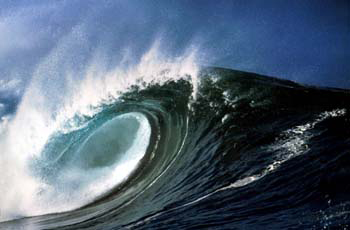December 17, 2007
The Promise Of Energy From The Sea

By Michael D. Shaw
Faced with ever-increasing energy costs, not to mention carbon footprint issues, all sorts of alternative energy schemes are being trotted out before a hopeful public. Certain of these, such as wind and solar power clearly work, but fail—at least now—when one considers practicality and scale.
Then there is the age-old notion of deriving energy from the sea. It has been estimated that if less than 0.1% of the energy available within the oceans could be converted into electricity, it would satisfy the present world demand for energy more than five times over.
A number of technologies exist to derive electrical power directly from the ocean, and these include tidal power, wave power, ocean thermal energy conversion, ocean currents, ocean winds, and salinity gradients. At the moment, the most well-developed of these are tidal power, ocean thermal energy conversion, and wave power.
As presently deployed, tidal power requires the erection of a dam across the opening of a tidal basin. Within the dam is a sluice that opens to allow the tide to flow into the basin, and then closes. As sea level drops, standard hydropower techniques are utilized to generate electricity from the water elevated in the basin.
Tidal power is no pipe dream: The largest such facility, La Rance station in France, generates 240 megawatts of power, with minimal environmental impact; although it has been noted that extensive use of tidal power could slow the Earth’s rotation by 24 hours every 2,000 years. In the U.S., tidal differences large enough to support tidal power occur only in Alaska and Maine.
Ocean thermal energy conversion (OTEC) makes use of the temperature differential between the warm surface waters of the oceans, heated by solar radiation, and the deeper cold waters to generate power in a conventional heat engine. To be economically practical, the temperature differential should be at least 36° F (20° C) in the first 3,281 feet (1,000 meters) below the surface.
Most present-day OTEC plants utilize the closed-cycle process, that employs a refrigerant such as ammonia. Heat transferred from the warm surface ocean water causes the working fluid to vaporize through a heat exchanger. The vapor then expands under moderate pressures, turning a turbine connected to a generator and thereby producing electricity. Cold seawater pumped up from the ocean depths to a second heat exchanger provides a surface cool enough to cause the vapor to condense. The working fluid remains within the closed system, vaporizing and re-liquefying continuously.
In 1979, American researchers put online the first OTEC plant able to generate usable amounts of electric power—about 15 kilowatts of net power. Mini-OTEC, as it was called, was mounted on a U.S. Navy barge off the coast of Hawaii. A few years later, the Japanese followed suit with a plant producing 35 kilowatts of net power. Continuing efforts are underway to enhance the process by improving heat exchanger design, and reducing seawater-caused corrosion.
Prospects for the commercial application of OTEC are optimistic, and favor tropical regions, and thus many developing nations. Authorities estimate that tropical ocean waters absorb solar radiation equivalent in heat content to that of about 170 billion barrels of oil each day. Even so, the ocean is so massive that removal of this much heat would not significantly alter its temperature, but would permit the generation of about 10 million megawatts of electricity on a continuous basis.
Wave energy conversion takes advantage of the ocean waves, caused primarily by interaction of winds with the ocean surface. No doubt, the energy contained within waves is enormous, with values as high as 43 megawatts/mile (70 megawatts/kilometer) having been observed.
At present, there are three types of wave energy collector…
- Buoyant Moored Device
- Hinged Contour Device
- Oscillating Water Column
A Buoyant Moored Device—as typified by the “duck” developed in Scotland—floats on the surface of the water, or just below it. While good energy conversion has been demonstrated in the lab, the complexity of the associated hydraulics has so far prevented a trial at sea.
The most successful Hinged Contour Device is the Pelamis. The sections of the device articulate with the movement of the waves, each resisting motion between it and the next section, creating pressurized oil to drive a hydraulic ram which drives a hydraulic motor. A series of such motors is used to drive generators to create power.
An Oscillating Water Column (OWC) generates power from the tide by using a column of water as a piston to pump air and drive a turbine. An OWC can be fixed to the seabed or installed on shore. This technology shows great promise, with the LIMPET 500 on Scotland’s Island of Islay currently generating 0.5 megawatts of power.
About the only downside of power from the sea is the necessary structures that might impede views, or spoil pristine shorelines. But considering that it creates no pollution, and is automatically renewable, it’s difficult not to embrace this gift from the sea.

